
Jacques Heim was a fashion designer ahead of his time, a creative force who reshaped the way the world perceived women’s fashion. Known for his fearless innovation, Heim didn’t just design clothes—he crafted statements. He dared to challenge societal norms, turning traditional fashion on its head and leaving a legacy that continues to influence modern designers. But what truly sets him apart? His vision went beyond fabric and stitching; Heim was a trailblazer who understood the intersection of fashion, culture, and individuality.
Table of Contents
Early Life and Background
Jacques Heim was born on May 8, 1899, in Paris, France, to a family engaged in the fur trade. Growing up in a household surrounded by luxury materials like fur, Heim developed an appreciation for fine craftsmanship early in life. Paris, often dubbed the fashion capital of the world, provided the perfect backdrop for his budding interest in the arts. His education further honed his skills, as he studied architecture before eventually transitioning into fashion. This background in structure and design gave him a unique perspective that would later manifest in his meticulously crafted garments.
Founding the Jacques Heim Fashion House
In 1923, Heim officially launched his own fashion house in Paris. His brand was rooted in elegance, luxury, and innovation. From the start, Heim was dedicated to creating designs that empowered women, celebrating their strength and beauty through fashion. His philosophy revolved around pushing boundaries—whether in terms of fabric choices, color palettes, or tailoring techniques. Heim’s atelier quickly became a hub for Parisian elites, who admired his ability to blend tradition with avant-garde aesthetics.
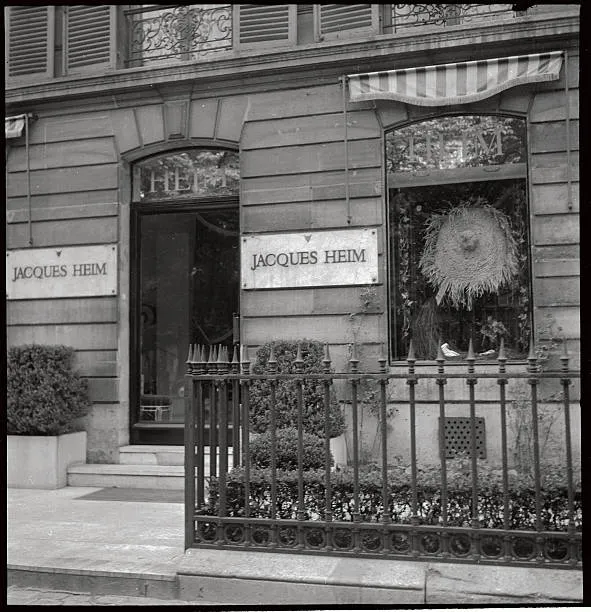
Photo by Sylvia Salmi/Bettmann via Getty Images
Design Philosophy
At the heart of Jacques Heim’s work was an unwavering commitment to elegance and innovation. His design philosophy revolved around creating pieces that celebrated the wearer’s individuality while maintaining a timeless appeal. Heim was a master of balance—his designs often combined bold, modern elements with the grace and refinement of traditional couture.
Heim believed that fashion should not only reflect the times but also push boundaries. This belief was evident in his ability to adapt to changing trends while maintaining a signature style. His creations were more than just garments; they were works of art that told a story of elegance, innovation, and empowerment.
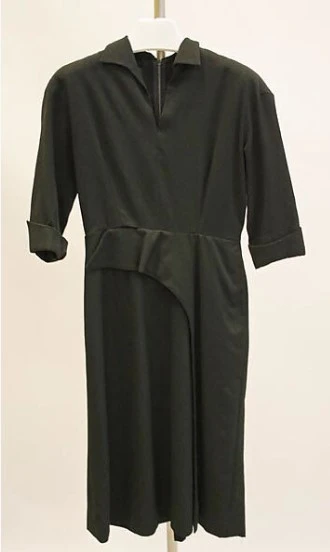
photo/metmuseum
Notable Collections and Works
Jacques Heim’s contributions to fashion were as bold as they were varied. One of his most iconic innovations came in 1946 with the introduction of the “Atome,” a two-piece swimsuit. Named after the smallest unit of matter, the design reflected the revolutionary post-war zeitgeist. Though initially overshadowed by Louis Réard’s bikini, the Atome was groundbreaking for its time and paved the way for more daring swimwear designs in the decades to come.
Heim’s collections also featured stunning evening gowns, tailored daywear, and outerwear that exuded sophistication. His use of intricate embroidery, rich fabrics, and architectural precision made his pieces stand out. Each collection was a testament to his ability to combine artistry with practicality, ensuring his designs were as functional as they were beautiful.
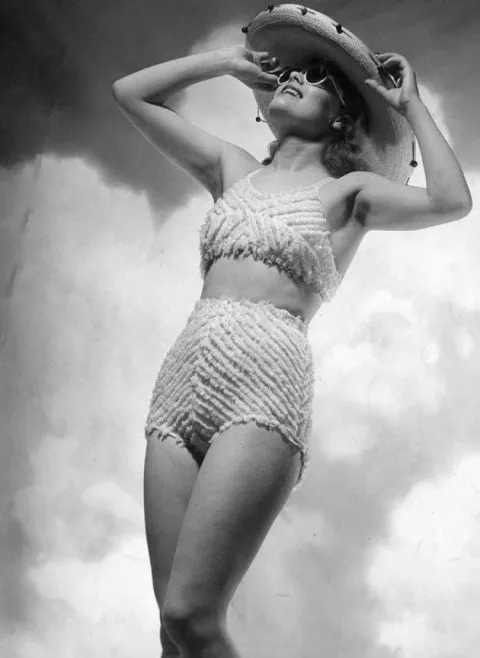
photo/pomezianews
Contribution to Haute Couture
Heim’s entry into haute couture was nothing short of revolutionary. At a time when women’s fashion was largely conservative, Heim introduced daring silhouettes that highlighted femininity without sacrificing comfort. His designs incorporated bold patterns, luxurious materials, and intricate details that were both timeless and modern. Heim believed that fashion should not just adorn the body but also reflect the personality of the wearer. This philosophy resonated with his clients, establishing his brand as a symbol of sophistication and innovation.
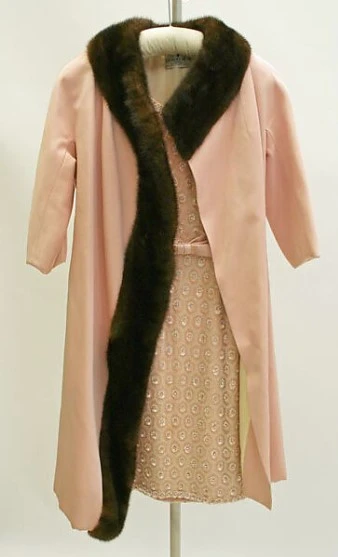
photo/metmuseum
The Impact of World War II
World War II posed immense challenges for fashion houses across Europe, and Jacques Heim’s atelier was no exception. With fabric shortages and economic instability, maintaining a luxury brand seemed almost impossible. However, Heim’s resourcefulness became his greatest asset. He adapted his designs to fit wartime restrictions, creating collections that were both practical and stylish. Heim’s commitment to preserving his brand during these trying times demonstrated his resilience and ingenuity, ensuring that his fashion house not only survived but thrived in the post-war era.
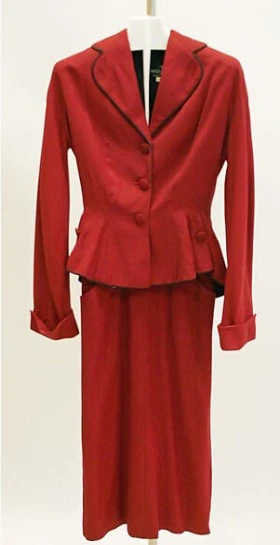
photo/metmuseum
The Bikini Controversy
One of Heim’s most famous contributions to fashion was the introduction of the “Atome” in 1946, a two-piece swimsuit that he marketed as the world’s smallest bathing suit. This bold creation came at a time when modesty dominated swimwear trends, and it immediately stirred controversy. Competing with Louis Réard, who introduced the “bikini” around the same time, Heim’s Atome played a pivotal role in changing societal perceptions of beachwear. While Réard’s bikini eventually became the more recognized term, Heim’s innovation laid the groundwork for the modern swimsuit industry.
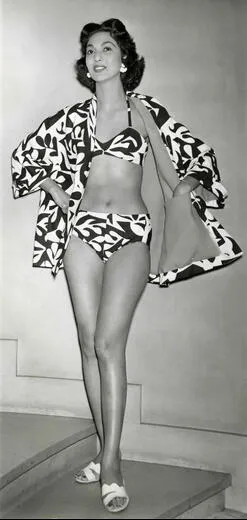
photo/alamy
Also Read-Marcel Rochas: The Visionary Behind Feminine Elegance
Reception of the Bikini
The public’s initial reaction to the bikini was mixed. While some celebrated it as a symbol of liberation and modernity, others deemed it scandalous and inappropriate. Heim faced criticism from conservative groups but remained steadfast in his belief that fashion should evolve with society. Over time, the bikini gained acceptance, becoming a staple in women’s swimwear and a cultural icon. Heim’s role in introducing this revolutionary garment showcased his ability to foresee and shape trends that would resonate for decades.
Collaboration
Jacques Heim’s influence extended beyond his own designs. He collaborated with prominent fashion artist Sonia Delaunay contributing to the development of new styles and techniques. Heim participated in international fashion exhibitions, where his creations were celebrated for their originality and craftsmanship. These collaborations allowed him to network with other visionaries, further cementing his reputation as a pioneer in the global fashion industry.
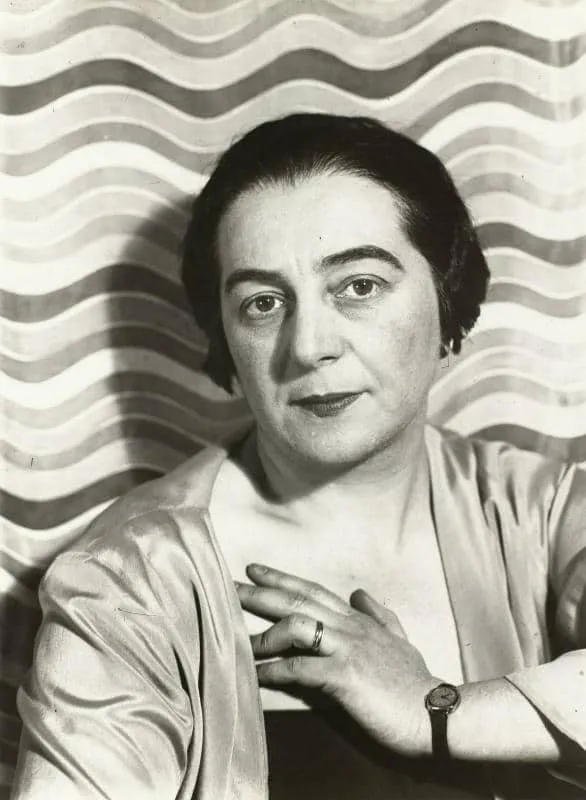
photo/fundacionmapfre
Celebrity Endorsements
The glamour of Jacques Heim’s designs was not lost on the world of entertainment. Hollywood icons such as Brigitte Bardot and Sophia Loren frequently donned his creations, bringing his work into the international spotlight. Heim’s designs became synonymous with elegance and sophistication, making them a favorite among celebrities who sought to make a statement on and off the red carpet.
His association with famous personalities amplified his influence, proving that his work resonated far beyond the confines of Parisian couture salons. These celebrity endorsements solidified Heim’s status as a designer who understood the power of visibility and cultural relevance.

photo/Brigitte Bardot/wiki
Advocacy for Modernism in Fashion
Heim was a staunch advocate for modernism in fashion, emphasizing the importance of simplicity and functionality. He believed that fashion should not just be aesthetically pleasing but also practical and accessible. His collections often featured minimalist designs that prioritized clean lines and versatile silhouettes. This modernist approach resonated with women who were seeking stylish yet wearable clothing, making Heim a favorite among contemporary fashion enthusiasts.
Jacques Heim’s Contribution to Ready-to-Wear
In addition to haute couture, Heim was a pioneer in the ready-to-wear market. Recognizing the need for accessible luxury, he created collections that bridged the gap between high fashion and everyday wear. This approach democratized fashion, allowing a wider audience to experience the elegance and sophistication of his designs. Heim’s foray into prêt-à-porter set the stage for the global ready-to-wear industry as we know it today.
Challenges Faced
Like many creative visionaries, Jacques Heim encountered significant challenges throughout his career. The onset of World War II disrupted the fashion industry, and Heim, being of Jewish heritage, faced additional hardships. He was forced to close his fashion house temporarily and lived under the constant threat of persecution.
Post-war, Heim had to navigate a drastically altered fashion landscape. The industry was shifting towards practicality and simplicity, driven by economic constraints and evolving consumer preferences. Despite these obstacles, Heim’s resilience and adaptability allowed him to rebuild his brand and remain relevant in a competitive market.
Jacques Heim Beyond Fashion
Heim’s interests extended beyond fashion, as he was an avid supporter of architecture and the arts. He believed that creativity was not confined to clothing but could be expressed in various forms. Heim’s passion for cultural preservation led him to support initiatives that celebrated French heritage, further solidifying his legacy as a multifaceted visionary.
Legacy of the Jacques Heim Brand
The Jacques Heim brand continued to flourish even after his death in 1967. His commitment to innovation and excellence left an indelible mark on the fashion world, inspiring generations of designers. Although the brand eventually ceased operations, its influence can still be seen in the works of modern couturiers who draw inspiration from Heim’s bold and visionary designs. His legacy lives on as a testament to the transformative power of fashion.
Jacques Heim at a Glance:
| Category | Details |
|---|---|
| Birth Date and Place | May 8, 1899, in Paris, France |
| Family Background | Born into a family engaged in the fur trade, which influenced his appreciation for luxury materials and fine craftsmanship. |
| Education | Studied architecture, which contributed to his understanding of structure and design. |
| Fashion House Founded | Established the Jacques Heim Fashion House in Paris in 1923. |
| Design Philosophy | Blended elegance, individuality, and innovation; believed in pushing boundaries while maintaining a timeless appeal. |
| Notable Invention | Created the “Atome,” a two-piece swimsuit introduced in 1946, considered a precursor to the modern bikini. |
| Specialization | Haute couture, evening gowns, tailored daywear, outerwear, and swimwear. |
| Collaboration | Worked with fashion artist Sonia Delaunay and participated in international fashion exhibitions. |
| Celebrity Clients | Brigitte Bardot and Sophia Loren frequently wore his designs, amplifying his influence. |
| Advocacy in Fashion | Advocated for modernism in fashion, emphasizing simplicity, functionality, and accessibility. |
| Contribution to Ready-to-Wear | Pioneered accessible luxury through prêt-à-porter collections, bridging haute couture with everyday fashion. |
| Impact of World War II | Faced challenges like fabric shortages and economic instability; adapted designs to wartime restrictions. |
| Challenges Faced | Encountered hardships during WWII as a Jewish designer, temporarily closed his fashion house, and navigated post-war shifts in fashion preferences. |
| Artistic Interests | Supported architecture and arts; involved in cultural preservation initiatives that celebrated French heritage. |
| Legacy | Left an indelible mark on the fashion industry; his vision continues to inspire modern designers. |
| Death | Passed away in 1967. |
| Key Contributions | Description |
|---|---|
| Haute Couture | Introduced daring silhouettes with bold patterns and luxurious materials that emphasized both femininity and comfort. |
| Swimwear Revolution | The “Atome” challenged societal norms, paving the way for modern swimwear designs. |
| Celebrity Endorsements | Designs became synonymous with elegance, worn by international stars and gaining global recognition. |
| Ready-to-Wear Fashion | Made high fashion accessible through elegant yet practical designs, helping establish the ready-to-wear industry. |
| Famous Work | Details |
|---|---|
| The Atome | A revolutionary two-piece swimsuit introduced in 1946, marketed as the smallest bathing suit of its time. |
| Evening Gowns | Renowned for intricate embroidery, rich fabrics, and architectural precision. |
| Tailored Daywear | Functional yet sophisticated designs for modern women. |
| Outerwear | Stylish and luxurious coats and jackets that balanced practicality and elegance. |
Conclusion
Jacques Heim was more than a fashion designer; he was a visionary who reshaped the industry with his creativity, resilience, and innovation. From haute couture to ready-to-wear, his contributions have left an enduring impact on the world of fashion. Heim’s legacy serves as a source of inspiration for those who dare to dream big and redefine the boundaries of their craft.
FAQs
1. Who was Jacques Heim?
Jacques Heim was a pioneering French fashion designer known for his contributions to haute couture, modern swimwear, and ready-to-wear fashion.
2. What is Jacques Heim’s most famous contribution to fashion?
Heim is widely recognized for introducing the “Atome,” one of the earliest versions of the bikini, which revolutionized swimwear.
3. How did Jacques Heim influence modern fashion?
By blending innovation with elegance, Heim set new standards in haute couture and democratized fashion through his ready-to-wear collections.
4. What challenges did Jacques Heim face during his career?
Heim overcame numerous obstacles, including fabric shortages during World War II and societal resistance to bold designs like the bikini.
5. Why is Jacques Heim still relevant today?
His timeless designs and forward-thinking philosophy continue to inspire modern designers, proving the enduring power of innovation in fashion.
One thought on “Jacques Heim: Behind the First Bikini Controversy and Beyond”